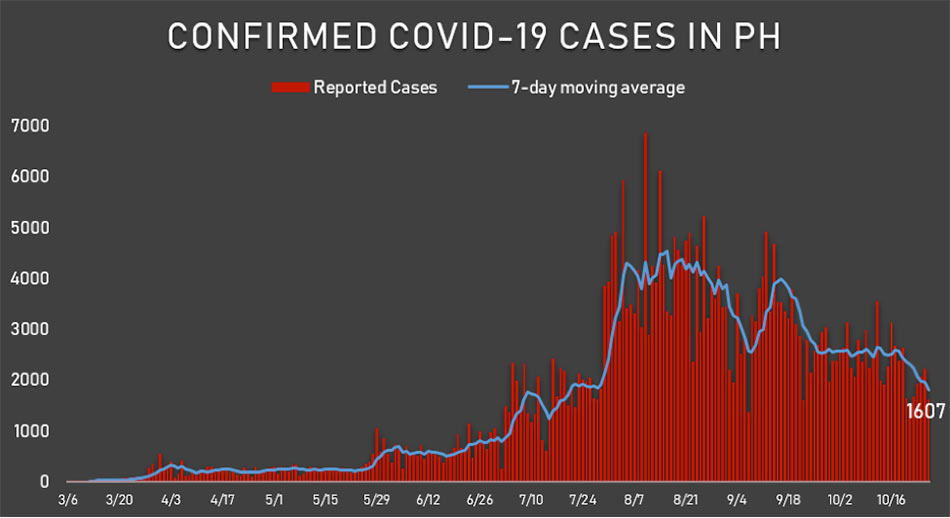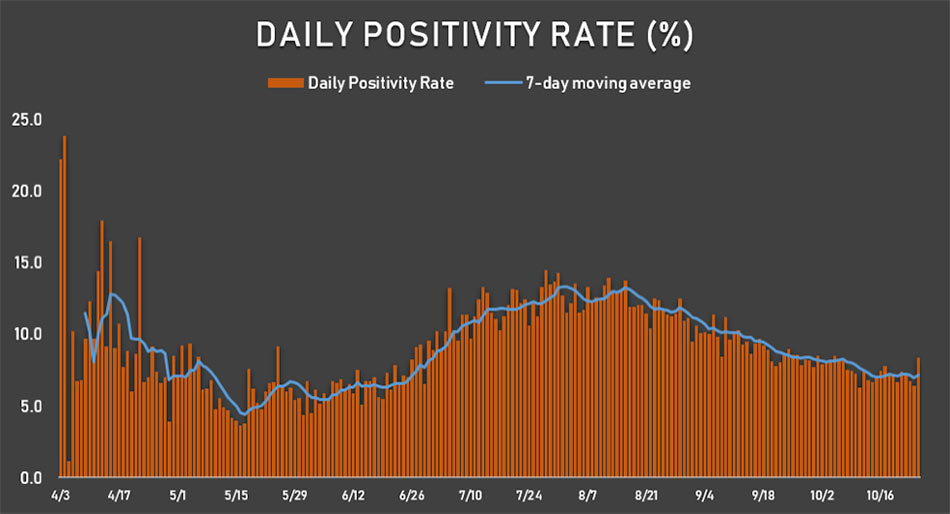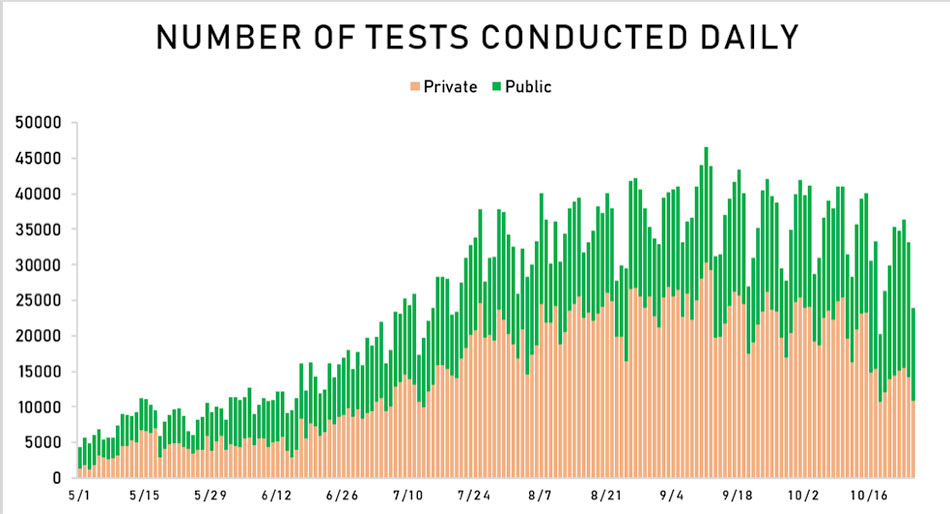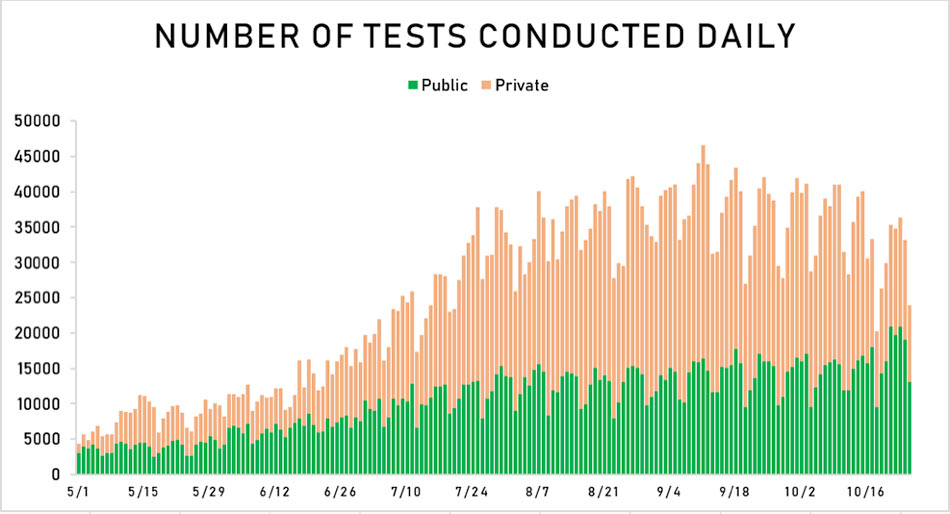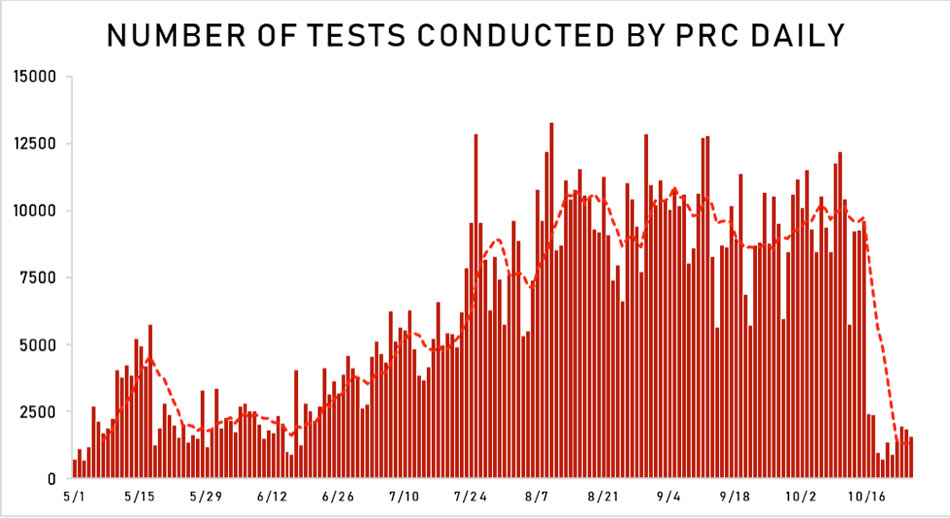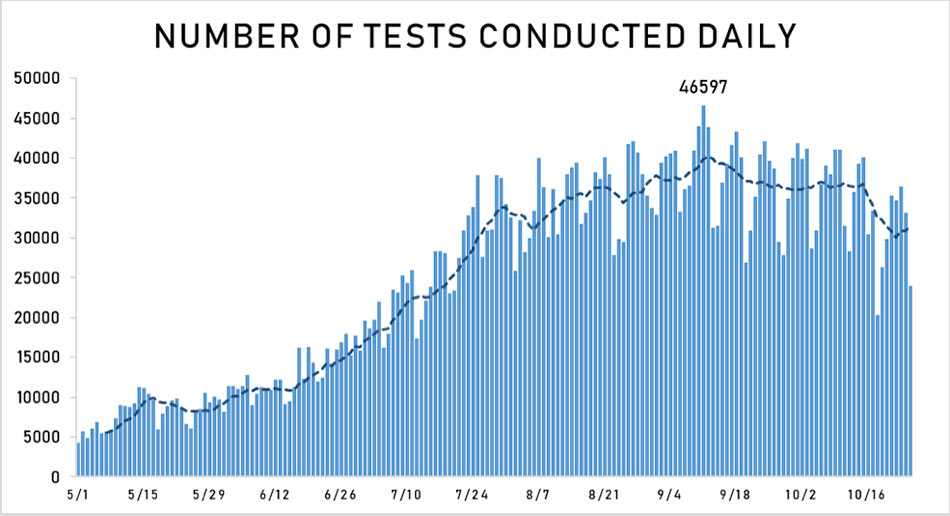Dissecting Data: PH Red Cross-PhilHealth row blinding gov’t to status of outbreak | ABS-CBN

Welcome, Kapamilya! We use cookies to improve your browsing experience. Continuing to use this site means you agree to our use of cookies. Tell me more!
Dissecting Data: PH Red Cross-PhilHealth row blinding gov’t to status of outbreak
Dissecting Data: PH Red Cross-PhilHealth row blinding gov’t to status of outbreak
Edson Guido and Warren de Guzman,
ABS-CBN News
Published Oct 27, 2020 07:45 PM PHT
|
Updated Oct 27, 2020 08:54 PM PHT
The Philippine government has promised to settle its over P1B unpaid debt for COVID-19 testing with the Philippine Red Cross (PRC) this week.
The Philippine government has promised to settle its over P1B unpaid debt for COVID-19 testing with the Philippine Red Cross (PRC) this week.
To date, the Philippine Red Cross has accounted for nearly a quarter of all COVID-19 testing. Without the PRC, the government would not have been able to accurately monitor the COVID-19 outbreak in the Philippines.
To date, the Philippine Red Cross has accounted for nearly a quarter of all COVID-19 testing. Without the PRC, the government would not have been able to accurately monitor the COVID-19 outbreak in the Philippines.
The payments were supposed to be made through state-run health insurer PhilHealth, but the agency is currently dealing with a massive internal corruption scandal, which saw no less than its previous chief, Ricardo Morales, facing criminal and administrative charges. A messy court battle is brewing.
The payments were supposed to be made through state-run health insurer PhilHealth, but the agency is currently dealing with a massive internal corruption scandal, which saw no less than its previous chief, Ricardo Morales, facing criminal and administrative charges. A messy court battle is brewing.
These events come at a crucial time, as the Philippine government attempts to reopen more of the economy. Authorities are being guided by data showing the positive cases of COVID-19 in the Philippines have gone down. But is the data reliable with testing on a downtrend due to the PRC-PhilHealth payment row?
These events come at a crucial time, as the Philippine government attempts to reopen more of the economy. Authorities are being guided by data showing the positive cases of COVID-19 in the Philippines have gone down. But is the data reliable with testing on a downtrend due to the PRC-PhilHealth payment row?
ADVERTISEMENT
Let’s take a look at the numbers.
Let’s take a look at the numbers.
Reported COVID-19 cases have been plateauing for weeks, and have now declined noticeably, as shown by the 7-day moving average of confirmed cases reflected by the blue line on this chart.
Reported COVID-19 cases have been plateauing for weeks, and have now declined noticeably, as shown by the 7-day moving average of confirmed cases reflected by the blue line on this chart.
Even better, the positivity rate, or the percentage of people testing positive for COVID-19 versus the total number of individuals tested, has also declined. From double digits just a few months ago, it is now at 7.1 percent over the past two weeks. That’s around two percentage points shy of the 5 percent level the World Health Organization set as a benchmark indicator for a clear decline in COVID-19 cases.
Even better, the positivity rate, or the percentage of people testing positive for COVID-19 versus the total number of individuals tested, has also declined. From double digits just a few months ago, it is now at 7.1 percent over the past two weeks. That’s around two percentage points shy of the 5 percent level the World Health Organization set as a benchmark indicator for a clear decline in COVID-19 cases.
But both these data points are only as good as the amount of testing done, and testing has unfortunately gone down due to the entirely avoidable reasons stated above.
But both these data points are only as good as the amount of testing done, and testing has unfortunately gone down due to the entirely avoidable reasons stated above.
This chart shows the number of COVID-19 tests conducted daily. Tests conducted by public or government-owned institutions such as the Research Institute for Tropical Medicine are shown in green.
This chart shows the number of COVID-19 tests conducted daily. Tests conducted by public or government-owned institutions such as the Research Institute for Tropical Medicine are shown in green.
Tests conducted by private sector institutions and non-government organizations such as the Philippine Red Cross are shown in yellow. The data show the private sector has been doing the heavy lifting in recent months when it comes to testing.
Tests conducted by private sector institutions and non-government organizations such as the Philippine Red Cross are shown in yellow. The data show the private sector has been doing the heavy lifting in recent months when it comes to testing.
If you invert the same chart to put private sector tests above public sector tests, the difference in the amount of work done becomes even more evident. Government needs its private sector and NGO partners to widen its testing and monitoring of the COVID-19 virus.
If you invert the same chart to put private sector tests above public sector tests, the difference in the amount of work done becomes even more evident. Government needs its private sector and NGO partners to widen its testing and monitoring of the COVID-19 virus.
This chart shows us COVID-19 tests done by the Philippine Red Cross. The number has significantly dropped since PRC decided to halt testing due to the unpaid testing bills of PhilHealth.
This chart shows us COVID-19 tests done by the Philippine Red Cross. The number has significantly dropped since PRC decided to halt testing due to the unpaid testing bills of PhilHealth.
PRC Chairman Senator Richard Gordon says they simply cannot continue without payment, because they don’t have funds to pay for more testing kits and the ongoing construction of additional testing lab facilities.
PRC Chairman Senator Richard Gordon says they simply cannot continue without payment, because they don’t have funds to pay for more testing kits and the ongoing construction of additional testing lab facilities.
The PRC has been averaging nearly 10,000 tests per day from August up to the first half of October. From October 16 to 22, PRC tested 10,073 in total (PRC stopped PhilHealth funded tests on October 16). What used to be the daily output became the weekly total.
The PRC has been averaging nearly 10,000 tests per day from August up to the first half of October. From October 16 to 22, PRC tested 10,073 in total (PRC stopped PhilHealth funded tests on October 16). What used to be the daily output became the weekly total.
Daily output of PRC:
Daily output of PRC:
- Oct 16 - 2,422
- Oct 17 - 2,360
- Oct 18 - 968
- Oct 19 - 708
- Oct 20 - 1,351
- Oct 21 - 887
- Oct 22 - 1,377
- Oct 23 - 1,944
- Oct 24 - 1,850
- Oct 25 - 1,547
- Oct 16 - 2,422
- Oct 17 - 2,360
- Oct 18 - 968
- Oct 19 - 708
- Oct 20 - 1,351
- Oct 21 - 887
- Oct 22 - 1,377
- Oct 23 - 1,944
- Oct 24 - 1,850
- Oct 25 - 1,547
(ABS-CBN Data Analytics, data from DOH)
This means that despite the payment row with PhilHealth, the PRC is still contributing to the daily testing effort, albeit at a much smaller scale, through non-PhilHealth-funded tests.
This means that despite the payment row with PhilHealth, the PRC is still contributing to the daily testing effort, albeit at a much smaller scale, through non-PhilHealth-funded tests.
This chart shows the total number of individuals tested by PRC daily and total positive cases detected per day. The positivity rate of tests from PRC labs declined to 4.2 percent from October 1 to 15, right up to the point when the PRC was forced to stop PhilHealth funded tests due to the payment row.
This chart shows the total number of individuals tested by PRC daily and total positive cases detected per day. The positivity rate of tests from PRC labs declined to 4.2 percent from October 1 to 15, right up to the point when the PRC was forced to stop PhilHealth funded tests due to the payment row.
Because of this, the number of positives reported by PRC labs has declined in the first half of October, but is still significant at around 400 daily (subject to deduplication). In recent days, it’s even lower because of the issue with PhilHealth.
Because of this, the number of positives reported by PRC labs has declined in the first half of October, but is still significant at around 400 daily (subject to deduplication). In recent days, it’s even lower because of the issue with PhilHealth.
PRC tests were contributing greatly to the government's ability to track the COVID-19 outbreak in the Philippines. Now, we don’t know if the favorable trend of lower positivity is still going.
PRC tests were contributing greatly to the government's ability to track the COVID-19 outbreak in the Philippines. Now, we don’t know if the favorable trend of lower positivity is still going.
As shown in this graph, PRC’s decision to stop PhilHealth funded tests contributed to a clear drop in overall testing starting October 16. Testing peaked at nearly 47,000 on September 11th. It has yet to top that, and has in fact declined.
As shown in this graph, PRC’s decision to stop PhilHealth funded tests contributed to a clear drop in overall testing starting October 16. Testing peaked at nearly 47,000 on September 11th. It has yet to top that, and has in fact declined.
There is evidence of laboratories attempting to pick up the slack created by the PRC-PhilHealth row, but it is clear that an immediate resolution of the payment issue would benefit all parties involved.
There is evidence of laboratories attempting to pick up the slack created by the PRC-PhilHealth row, but it is clear that an immediate resolution of the payment issue would benefit all parties involved.
The goal of the Philippine government was to test 30,000 per day by the end of May. It met that goal on July 22, nearly two months after the deadline.
The goal of the Philippine government was to test 30,000 per day by the end of May. It met that goal on July 22, nearly two months after the deadline.
Some government officials and groups were advocating for daily tests to hit 50,000. But again the data show testing is far from that mark. More importantly, the charts above show the Philippines has never consistently averaged more than 30,000 tests per day without the Philippine Red Cross.
Some government officials and groups were advocating for daily tests to hit 50,000. But again the data show testing is far from that mark. More importantly, the charts above show the Philippines has never consistently averaged more than 30,000 tests per day without the Philippine Red Cross.
Average tests per day (PH)
Average tests per day (PH)
- August - 34,789
- September - 37,541
- October (1-15) - 36,892
- August - 34,789
- September - 37,541
- October (1-15) - 36,892
Average tests per day (PRC)
Average tests per day (PRC)
- August - 9,532
- September - 9,409
- October (1-15) - 9,808
- August - 9,532
- September - 9,409
- October (1-15) - 9,808
(ABS-CBN Data Analytics, data from DOH)
President Rodrigo Roa Duterte himself has promised to look for the funds to pay off PhilHealth’s debt to the PRC, but Gordon says government lawyers are doing everything in their power to get out of the debt.
President Rodrigo Roa Duterte himself has promised to look for the funds to pay off PhilHealth’s debt to the PRC, but Gordon says government lawyers are doing everything in their power to get out of the debt.
However Duterte was very clear that the priority in this situation should be the medical considerations, and healthcare experts from all sectors are clamoring for more testing to help keep tabs on the COVID-19 virus in the Philippines.
However Duterte was very clear that the priority in this situation should be the medical considerations, and healthcare experts from all sectors are clamoring for more testing to help keep tabs on the COVID-19 virus in the Philippines.
This payment row is threatening to blind the Philippine government to true conditions on the ground.
This payment row is threatening to blind the Philippine government to true conditions on the ground.
Whatever issues PhilHealth has with the debt incurred need to be resolved immediately. It can’t be stressed enough, the PRC has made a significant contribution to the Philippines’ fight against COVID-19. Their help will be needed if the fight is to be won.
Whatever issues PhilHealth has with the debt incurred need to be resolved immediately. It can’t be stressed enough, the PRC has made a significant contribution to the Philippines’ fight against COVID-19. Their help will be needed if the fight is to be won.
ADVERTISEMENT
ADVERTISEMENT


